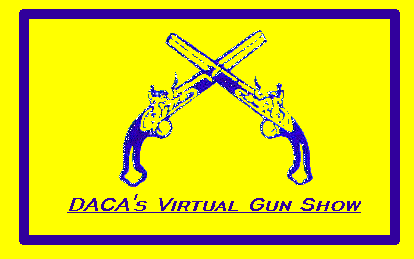

Gun and Knife Show Information
Virtual Gun Show
DACA's Mission Statement
Club Officers
Club Newsletter
Upcoming Events
Useful Links
DACA's Book Store
Club Resources
Home
Allen and Wheelock Lipfire conversions
One of the strongest revolver designs of the American Civil War period was the Allen and Wheelock center hammer lipfire revolv-er. This revolver was marketed in two models, the Army version and the Navy version.
The Army model is .44 lipfire caliber. It has a six shot round cylinder with notches for the cartridge lips at the rear wall. The half round, half octagon barrel was 7 1/2 inches long. They were issued with walnut grips, blued finish with case hardened hammer and trigger guard.
The Navy model is quite similar with the exception that it is .36 lipfire and it has an 8 inches long octagonal barrel. Barrels on this model also came in 4, 5, 6 and 7 1/2 inch lengths.
Patent secured
The lipfire cartridge was patented by Ethan Allen on Sept. 25, 1860. The patent number is 30109. This odd cartridge along with the teatfire and the cup primer cartridges were designed to circumvent the Rolin White patent which provided for the boring clear through of the cylinder chambers to permit the loading of the cartridge from the breach end.
The purpose of the patent in Allen's words was, "for constructing a metallic cartridge with a projection of a lip for the reception of the fulminate. . . by confining the fulmate to the projection, I therefore save about seven-eighths of the expense of the compound, and lesson the liability, in the same proportion of blowing the cartridge end, which often occurs exploding those in common use. I also make a stronger head, or back end to the cartridge which oblivates the difficulty of swelling back of the head of the cartridge which is common in other modes of construction."
A lipfire round as described above, had no flanges, just a small lip which extended out through a notch in the cylinder to be struck by the hammer. Lipfires were manufactured in .25, .32, .36 and .44 calibers.
Less than a thousand of these revolvers were produced when in Nov. 1863. Allen & Wheelock was forced to cease production because of an injunction secured by Rolin White.
Because of this it is likely that the production of lipfire cartridges was reduced considerably.
What better solution for the owners of these new large caliber revolvers than to convert them for metallic cartridges that were already available? To make matters even better for these Civil War era owners is a disadvantage for modern collectors.
Numerous .36 caliber Navy and .44 caliber Army revolvers converted to use .38 rimfire and .44 rimfire cartridges are believed by their modern owners to be in the original lipfire configuration.
How to distinguish a conversion
It's fairly easy to tell a lipfire from a conversion. The reason for mis-identification is that when the guns were converted, the rear of the cylinders which were flat-faced and not counter bored, were not faced off. Thus the lip slots were not eliminated. The chambers of these converted cylinders were counter-bored to deal with the rimfire cartridge langes, and in the case of the .36 caliber guns the cylinders were reamed to the .38 caliber dimensions. (Reaming the chambers on the .44s was not necessary because they were already the correct size.)
It should be noted that even though the .38 bullet was not the best fit, the bore of the barrel of the Navy models was not enlarged.
The other common modification was to enlarge the loading channel through the right rear frame and recoil shield. This modification is hard to see from the outside of the gun, but a close look at the fit between the closed loading gate and the loading channel after the cylinder has been removed will establish whether or not the loading channel has been slightly enlarged.
A factory loading channel and loading gate will have a tight and symmetrical fit while an enlarged channel results in an uneven fit between the loading gate and loading channel.
Factory conversion improbable
It may be assumed that because of the many variations found in Allen and Wheelock conversions and the injunction secured by Rolin White, it seems unlikely that any conversion could have been done at the factory. All are private conversions done by independent gunsmiths.
Rod WrightBibliography:
A Study of Colt Conversion and Other Percussion Revolvers by R. Bruce McDowell; published by Krause Publications, Iola, Wisc.
Cartridges a Pictorial Digest of Small Arms Ammunition by Herschel C. Logan; Special addition of 1000 copies.
Flayderman's Guide to Antique American Firearms. . . and Their Values6th edition by Norm Flayderman; published by DBI Books, Inc., Northbrook, Ill.
U.S. Cartridges and Their Handguns 17951975 by Charles R. Suydam; published by Beinfeld Publishing, Inc., North Hollywood Calif.